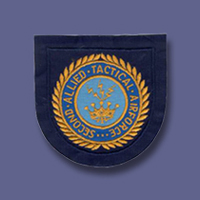Tactical Air Control System |
|||
|
|||
| 2nd Allied Tactical Air Force | |||
| (Source: FLIGHT International, 3 June 1965) | |||
| FIREBRIGADE MK2 The Elliott Firebrigade Mk 2 computerized air defense control system was delivered in February 1965 to the RNAF and installed at the main RNAF air defense operations center at Den Helder, the Netherlands. The Firebrigade system is based on the Elliott MCS 920 computer and is capable of controlling the supersonic F-104G interceptors. The system is compatible with both surface-to-air missiles (SAM) as well as manned aircraft. The system advises the controllers whether to intercept an approaching "hostile" with manned aircraft or SAMs, selects which defensive air base or missile battery to use and which aircraft type. Fighter Intercepts -- The system presents control instructions for the interceptor to bring the fighter into a firing position - heading; when to climb and to what height; speed; when to accelerate or to turn. (At Den Helder, these instructions are relayed verbally by ground controllers to the interceptor but the system is capable of digital ground-air links.) SAM Intercepts -- the system aims the missile and indicates when to fire. ADDITIONAL INFORMATION The Royal Netherlands Air Force (RNAF) has two squadrons of all-weather F-104G Starfighters stationed at Leeuwarden: 322 Squadron and 323 Squadron. They perform the air defense mission. Each squadron is equipped with 18 aircraft (three flights of six F-104G's). No 323 Sqn began operations with the Starfighter in March 1964; No 322 Sqn transitioned to the F-104G in July 1964. Together with the computerized control system installed at the Den Helder radar station, the RNAF probably has the best air defense set-up in NATO (Webmaster: this is the opinion of the author of the FLIGHT International article, not the webmaster's.) The RNAF air defense system is supplemented by a Hunter day-fighter squadron and the 32nd FIS (USAFE F-102 squadron) at Soesterberg Air Base. |
|||
| (Source: FLIGHT International, 25 April 1968) | |||
| MINIMUM FACILITIES PROGRAM On 9 April 1969, the Programming & Training Center (PTC) at Glons became operational as the first element of the four-station air defense network being installed under the International Planning Group minimal facilities program (cost £9 million). Ultimately, the four stations will be integrated with NADGE once that computerized control and reporting chain is operational. The program includes four CRC's that will use data-link to automate fighter control. The four CRC's are Uedem, Brockzetel, Glons (Belgium) and Nieuw Milligen (the Netherlands). Together they cover a large part of the 2nd ATAF area of responsibility. All will become operational before year's end. The IPG concept was initiated in 1958 when the three countries (West Germany, Belgium, the Netherlands) decided to speed up the integration of their radar stations instead of waiting for the NADGE system to become reality. The manual operations centers (using telephones for reporting and tables for manual plotting) were integrated in 1961. With the arrival of the F-104G Starfighters, a much improved, computerized air defense control system was needed and the "minimum facilities program" initiated. A contract for the IPG air defense ground environment system was signed with Hughes Aircraft in Fullerton, Calif. in October 1964. The PTC is located inside the bunker that will also house the IPG control & reporting center. Two areas within the bunker are part of the PTC. Five training consoles (identical to the ones that will be used in the operations room) will be used for basic training (simulated intercepts) at the PTC. Follow-on training will be provided at the four operational IPG stations. The Netherlands independently also commissioned an Elliott Firebrigade system at Den Helder as an off-the-shelf interim system. Once the Nieuw Milligen station is up and running, the Den Helder system will serve as a back up for the IPG system. |
|||
| (Source: FLIGHT International, 1 August 1968) | |||
| Installation of the two West German air defense control and reporting centers in the IPG network has been completed: Brockzetel and Uedem. The four station, three-nation (West Germany, Belgium, the Netherlands) International Planning Group air defense network is a forerunner of the Norway-to-Turkey NADGE system that is currently being built. (The other two stations are at Glons, Belgium and Nieuw Milligen, the Netherlands.) |
|||
| Air Defense Operations Center / TACC / SOC | |||
| ADOC Maastricht | |||
| (Source: Email from Martyn Perring, RAF veteran) | |||
| To update your page detailing the 2ATAF ADOC callsign which you speculate may have been "STATIC". If I recall correctly that was part of the plain language signal address which was "2ATAF STATIC." As a Royal Air Force Corporal, I worked in the 2ATAF ADOC at Maastricht, which is in the Netherlands not Belgium. Although the entrance to the caves we worked in was in the Netherlands, some parts of the cave complex were in Belgium. The Dutch/Belgian border was located at Kanne, about 400 yards from the entrance to the caves which were dug into a sandstone hill called the Kanneberg. I was there from May 1985 to June 1988 and throughout that period the callsign we used was "DUSTBIN". Not my favourite! Hope this helps to fill in some gaps... |
|||
